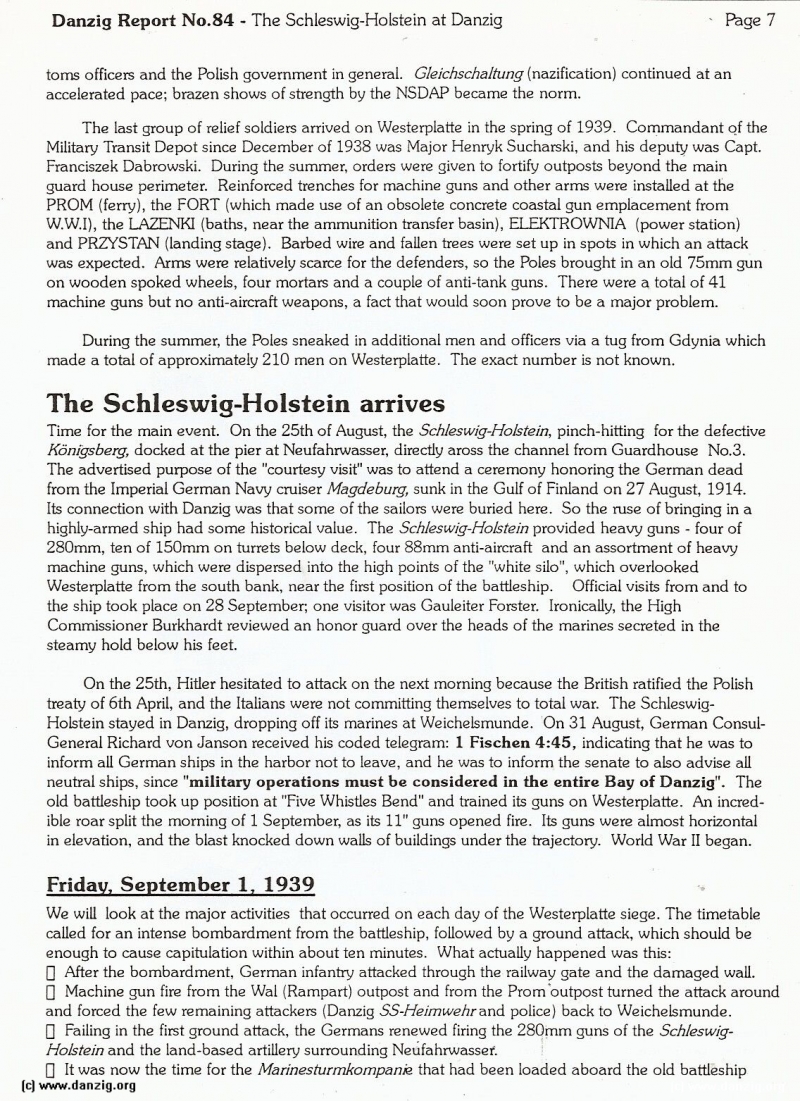
toms officers and the Polish government in general. Gleichschaltung (nazification) continued at an accelerated pace; brazen shows of strength by the NSDAP became the norm.
The last group of relief soldiers arrived on Westerplatte in the spring of 1939. Commandant of the Military Transit Depot since December of 1938 was Major Henryk Sucharski, and his deputy was Capt. Franciszek Dabrowski. During the summer, orders were given to fortify outposts beyond the main guard house perimeter. Reinforced trenches for machine guns and other arms were installed at the PROM (ferry), the FORT (which made use of an obsolete concrete coastal gun emplacement from W.W.I), the LAZENKI (baths, near the ammunition transfer basin), ELEKTROWNIA (power station) and PRZYSTAN (landing stage). Barbed wire and fallen trees were set up in spots in which an attack was expected. Arms were relatively scarce for the defenders, so the Poles brought in an old 75mm gun on wooden spoked wheels, four mortars and a couple of anti-tank guns. There were a total of 41 machine guns but no anti-aircraft weapons, a fact that would soon prove to be a major problem.
During the summer, the Poles sneaked in additional men and officers via a tug from Gdynia which made a total of approximately 210 men on Westerplatte. The exact number is not known.
The Schleswig-Holstein arrives
Time for the main event. On the 25th of August, the Schleswig-Holstein, pinch-hitting for the defective Kônigsberg, docked at the pier at Neufahrwasser, directly aross the channel from Guardhouse No.3. The advertised purpose of the “courtesy visit” was to attend a ceremony honoring the German dead from the Imperial German Navy cruiser Magdeburg, sunk in the Gulf of Finland on 27 August, 1914. Its connection with Danzig was that some of the sailors were buried here. So the ruse of bringing in a highly-armed ship had some historical value. The Schleswig-Holstein provided heavy guns - four of 280mm, ten of 150mm on turrets below deck, four 88mm anti-aircraft and an assortment of heavy machine guns, which were dispersed into the high points of the “white silo”, which overlooked Westerplatte from the south bank, near the first position of the battleship. Official visits from and to the ship took place on 28 September, one visitor was Gauleiter Forster. Ironically, the High Commissioner Burkhardt reviewed an honor guard over the heads of the marines secreted in the steamy hold below his feet.
On the 25th, Hitler hesitated to attack on the next morning because the British ratified the Polish treaty of 6th April, and the Italians were not committing themselves to total war. The SchleswigH olstein stayed in Danzig, dropping off its marines at Weichelsmunde. On 31 August, German Consul- General Richard von Janson received his coded telegram: 1 Fischen 4:45, indicating that he was to inform all German ships in the harbor not to leave, and he was to inform the senate to also advise all neutral ships, since “military operations must be considered in the entire Bay of Danzig”. The old battleship took up position at “Five Whistles Bend” and trained its guns on Westerplatte. An incredi ble roar split the morning of 1 September, as its 11” guns opened fire. Its guns were almost horizontal in elevation, and the blast knocked down walls of buildings under the trajectory. World War II began.
Friday, September 1, 1939
We will look at the major activities that occurred on each day of the Westerplatte siege. The timetable called for an intense bombardment from the battleship, followed by a ground attack, which should be enough to cause capitulation within about ten minutes. What actually happened was this: o After the bombardment, German infantry attacked through the railway gate and the damaged wall.O Machine gun fire from the Wal (Rampart) outpost and from the Promoutpost turned the attack around and forced the few remaining attackers (Danzig SS-Heimwehr and police) back to Weicheismunde.o Failing in the first ground attack, the Germans renewed firing the 280mm guns of the SchleswigH o/stein and the land-based artillery surrounding Neifahrwasser.O It was now the time for the Marinesturmkompame that had been loaded aboard the old battleship
Danzig Report Vol. 1 - Nr. 84 - July - August - Sept - 1994, Page 7.
Hits: 3477
Added: 09/07/2015
Copyright: 2025 Danzig.org

